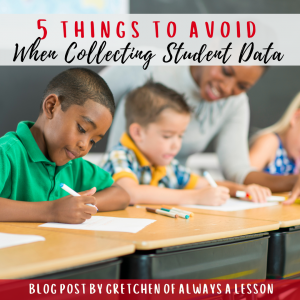5 Things to Avoid when Collecting Student Data
Collecting student data is considered a best instructional practice in today’s schools. It allows teachers to know exactly how well students know and understand the material being taught to them. However, data collection processes can be confusing to implement which could result in inaccurate student data.
This post will explore 5 things to avoid when collecting student data so that all information collected is as accurate and timely as possible.
Inconsistency
 One way to ensure teachers collect accurate data is to remain consistent in your data collection practices. Teachers will want to compare data over a period of time. When data collection happens consistently (ie. similar time of day, time, subject area, method, and tools used) we can eliminate aspects that negatively impact the results. For example, comparing two different subject areas would not lead to logical conclusions or looking at a student’s math performance before lunch when they’re hungry and after lunch when they are full could lead to a discrepancy in effort, thoroughness and accuracy. Staying consistent in what and how student data is collected is essential for the information to be as accurate and usable as possible.
One way to ensure teachers collect accurate data is to remain consistent in your data collection practices. Teachers will want to compare data over a period of time. When data collection happens consistently (ie. similar time of day, time, subject area, method, and tools used) we can eliminate aspects that negatively impact the results. For example, comparing two different subject areas would not lead to logical conclusions or looking at a student’s math performance before lunch when they’re hungry and after lunch when they are full could lead to a discrepancy in effort, thoroughness and accuracy. Staying consistent in what and how student data is collected is essential for the information to be as accurate and usable as possible.
Time
For a teacher to gather student performance data while students are working, the assignment given to them must be long enough to keep students engaged while the teacher is making the rounds. Data collection doesn’t have to take an inordinate amount of time, and teachers do not always have to collect data from every student (ie. you might want to only collect a subset of data for a specific group of students to check progress). Giving an assignment that students complete quickly leads to misbehavior and a rushed data collection process, potentially negatively affecting results. Therefore, teachers must pace their lesson activities so that the allotted time for students to complete assignments incorporates collecting all of the necessary data.
Misalignment
In order to use the data collected from student work to make instructional decisions for subsequent lessons, the work must be reflective of the taught standard. This means if teachers are going to assess students on a specific skill recently taught, the activity students complete and that the teacher analyzes must be similar. If students are taught one thing and assessed on something different, the data will not be reflective of the level of student understanding for what was taught. Therefore, teachers need to ensure. they plan and prepare similar exercises for students to complete throughout the lesson- direct instruction, guided practice, independent practice and assessment. Aligning all parts of the lesson with data collection processes will generate the most accurate results.
Lack of Implementation
Collecting student data is useless if teachers do not take the time to review it. Even with the best of intentions, the school day can be busy and teacher requirements can be overwhelming that there is not enough time to review data. Or worse, data is reviewed but there is not enough time to develop a plan of implementation. As a result, teachers might not be able to design adjustments to their instruction before the following day’s lesson. To avoid this, administrators can build in time during the school day for teachers to review data, student work, and plan future lessons to meet student needs. If this is not a possibility, teachers can still make data reflection a part of their daily ritual before going home for the day- even if its for 5 minutes. Using the data to adjust instruction is a powerful way to improve student learning outcomes.
Teacher Owned Process
If teachers are always the ones collecting and reviewing data, students do not fully know or understand the benefits of being aware of their academic performance. Students can be part of the data collection process, not just by producing the work sample, but by comparing their efforts to a model example. This allows students to see the gap from where they are and where they need to be (and what that looks like). When students collect and analyze their own performance data, they are much more invested in the learning process. They want to improve and are proud when they visually see their performance increase. Teachers should allow students to be part of the data collection process.
Next Steps
- Grab these data tracking sheets to help students track their own academic performance
- Read the previous blog post on data tracking to strengthen your data collection procedures
- Check out my instructional coaching must-haves
GO BE GREAT!

What obstacle have you faced when collecting student data?
